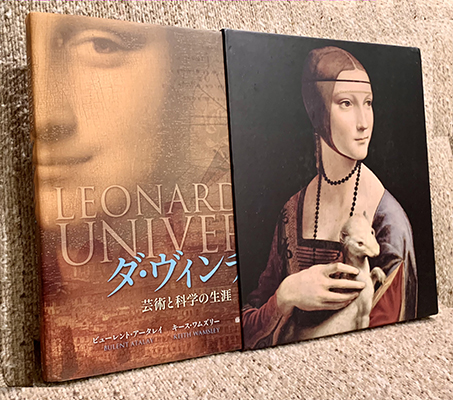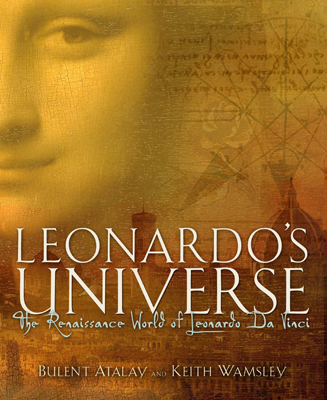LEONARDO'S UNIVERSE
The Renaissance World of Leonardo da Vinci
by
Bulent Atalay and Keith Wamsley
![]() NATIONAL GEOGRAPHIC BOOKS
NATIONAL GEOGRAPHIC BOOKS
Offering a new look at the astonishing genius of Leonardo da Vinci, a celebrity in the book world more than five centuries after his birth, Leonardo's Universe: The Renaissance World of Leonardo da Vinci (National Geographic Books, January 2009, ISBN: 978-1-4262-0285-8) reveals the man in full. This multi-dimensional portrait is unique in connecting Leonardo’s brilliance in mathematics and the sciences with his extraordinary artistic talents.
Co-authors — Bulent Atalay, a scientist and artist who wrote Math and the Mona Lisa: The Art and Science of Leonardo da Vinci (now in 12 languages), and Keith Wamsley, a classicist and historian — skillfully illuminate Leonardo’s legacy in all its many facets. They portray him as a poignantly tragic character, who, more than any other, invented the future, but did not influence it. We stand in awe of his accomplishments and at the same time feel frustrated that he did not complete more of his commissions. So many of the devices that he invented and so many of the natural laws that he discovered would not come to light until centuries later, after they were developed independently or rediscovered anew.

Leonardo's Universe (Japanese Edition).
Among the many astounding revelations in Leonardo's Universe:
-
Leonardo produced less than twenty paintings in his entire life, yet two of them are among the most famous works in the history of art.
-
Not only was Leonardo left-handed, he wrote backwards in “mirror text” (most likely to avoid smearing the ink and snagging the point of his quill in the paper).
-
Leonardo frequently used his fingers to mix colors on the surface of his paintings. His fingerprints are now on file with the FBI.
-
Leonardo’s surpassing prescience is evident in his sketch-filled notebooks. He invented entire fields of science hundreds of years before they were reinvented by future scientists: geology, physics, aeronautics, hydrodynamics, meteorology, physiology…
-
A century before Galileo, Leonardo recognized the parabolic trajectories of projectiles and the constant acceleration of falling bodies.
-
160 years before Newton invented the reflecting telescope (circa 1668), Leonardo designed it.
-
Leonardo designed a tank, submarine, pontoon shoes, dredger, odometer, anemometer, hygrometer, and perhaps even a bicycle.
-
With visions of human flight, he designed strap-on ornithopter wings, an aerial screw (foreshadowing the helicopter), and a parachute — 400 years before heavier-than-air human flight became a reality.
-
Leonardo invented robotics a full five centuries before our age, when this technology has become an integral part of modern manufacturing.
-
Prefiguring Darwin by 350 years, Leonardo made a statement recognizing the necessity of organisms to evolve in order to survive.
-
He described hardening of the arteries (atherosclerosis) four hundred years before physicians at the University of Vienna Medical School identified the disease.
-
Leonardo appears to have understood circulation of blood more than a century before William Harvey’s discovery of the phenomenon.
-
Leonardo’s anatomical drawings are the best ever produced. Cardiac surgeon Francis Wells in Cambridge (UK) introduced a new technique in mitral valve repair inspired by Leonardo’s drawings of the human heart and his general methodology, and has successfully applied the technique on over 250 patients.
Magnificently illustrated and richly visual, Leonardo's Universe deftly explores the master’s insights and brilliance through his own art and writings against the spellbinding backdrop of the Renaissance world.
REVIEWS
"Another book on Leonardo da Vinci? Yes, and for good reasons: Leonardo is an inexhaustible subject, and Atalay, a physicist, [and co-author, Wamsley] bring an unusual blend of scientific and artistic perspective to bear on Leonardo’s life."
Greg McNamee, 'Ten Must-Have Reference Books from 2008.'
Encyclopedia Britannica Blog, Dec. 30, 2008.
"Atalay and Wamsley's wise and illuminating text comes together with the jawdroppingly beautiful images we've come to expect from National Geographic to create a truly stunning journey through Leonardo's life and career."
— Ross King, author of Brunelleschi's Dome,
Ranked first on the New York Times Best Seller list.
![]()
"I am just beginning to inhale this huge volume of Leonardo's history, insights, art and science. It's truly fascinating reading with stunningly beautiful drawings, paintings and photographs. Each page is a visual delight!! It is a treasured addition to my collection of art and science books and an inspiration to my photographic visions. However, "Leonardo's Universe", is more than the usual historical review of da Vinci's genius. It is an inspiration to all artists and scientists who endeavor to transcend current perceptions of art and scientific knowledge and leap beyond incremental approaches
The creative connection between art and science was one of the themes that was exploited by the acclaimed NASA Institute for Advanced Concepts (NIAC). The NIAC was funded by NASA from 1998 through August 2007 to inspire, select and fund revolutionary advance concepts for future aerospace endeavors. The NIAC expanded on the creative genius of numerous scientists and artists from da Vinci to modern day Einstein and Picasso, and others, to inspire thinking and concepts that could have significant impact on future aerospace missions. Bulent Atalay's book "Math and the Mona Lisa" was one of the primary references used by NIAC as an example of the connection between art, math and science. His latest book, co-authored with Keith Wamsley, will also be an essential reference and inspiration for creative scientists and "techno" artists and a treasured addition to any library focused on art and science."
— Robert A. Cassanova, PhD
Former Director, NASA Institute for Advanced Concepts"
![]()
"This stunning book is a work of art that will enhance the beauty of any coffee table or library shelf. Here we have a work that not only the Renaissance historian will relish but which also has appeal for the art-loving scientist and science-loving artist. It is profusely illustrated throughout with color images of Leonardo's artwork, maps, diagrams engineering projects, and sketchbooks as well as the works of his contemporaries. Photographs of Modern Europe that pertain to Leonardo's time are added to add context and texture. Even when skimming through the pages, one can immediately grasp the significance of the "rebirth of the classical past" in Europe if not world history. This is both a biography of Leonardo the artist, scientist, and inventor, and a history of the Italian Renaissance as symbolized by Leonardo, the orginal ultimate Renaissance man. Also of interest are the chapters that include information on th role of science and mathematics in art. We learn that Leonardo prefigured by several decades the birth of modern science, said to have begun with the works of Copernicus in the physical sciences and Vesalius in the biological. And we are given details about the use of modern technology in the restoration and provenance of artworks. I was interested to learn, for example, that Leonardo's fingerprints are on file at the FBI, who labs were used to confirm that his figerprints were saved for posterity in the late-fifteenth-century painting Ginevra.
A book of this kind is a labor of love. It is evident that it is a product of years of research, attention to detail, and dedication to a beloved subject. It won't disappoint the reader."
— Alice Calaprice
Former Senior editor at Princeton University Press; author of The Quotable Einstein books.
![]()
"There are many reasons to read this wonderful book. It has the gorgeous graphics of an elegant coffee table book but is also a lively, rigorous and informative narrative one wants to read in the comfort of his or her den. The authors are Renaissance men themselves and these qualities are reflected in the book. This account of Leonardo's life and the world in which he lived is clearly written and will appeal to the layman as well as to scholars. The illustrations and photographs are exceptionally well chosen. The narrative is enhanced by scores of supplementary vignettes such as, "Ideal Proportions", "Leonardo's Mirror Text", "Pyramidal Composition", "Mathematical Underpinnings",and "Leonardo as an Urban Planner". This is the special sort of book that never loses its freshness.".
— Robert H. Stegeman
Academic Dean (retired), St. Andrew's School"
Omtale fra Nielsen Bookdata
"Leonardo's Universe" demystifies DaVinci's insights. Books have been written about Leonardo's notebooks, his paintings, his ideas, and his genius, but none has synthesized his relationship with art and science in such a richly illustrated, informative format. Every page of this book resonates with Leonardo's genius. Special diagrams drawn by the author, himself an artist, show how Leonardo applied "golden proportions," Fibonacci sequences, and other mathematical principles to his art. Recreations of Leonardo's inventions, built by IBM in the 1960s reveal a mind that is only now being fully understood. And throughout, insightful quotations drawn from Leonardo's writings reveal the thoughts and inspirations behind the ideas of a man who upon his death asked God's forgiveness for "not using all the resources of my spirit and art." Wonderfully illustrated with more than 200 visuals, compellingly written, and filled with surprises at every turn, "Leonardo's Universe" is a riveting journey through a time like no other, alongside the achetypical 'Renaissance Man. This book captures the genius and spirit of Da Vinci and the time in which he lived - a period of history that would influence his burning passions for art and science and an era upon which had an enduring influence."
Order your copy:
Contact Information : drbatalay@gmail.com • Telephones: (540) 898-0355 and (540) 845-4962 • Wikipedia Entry• YouTube

